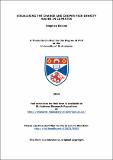Files in this item
Visualising the charge and Cooper pair density waves in cuprates
Item metadata
| dc.contributor.advisor | Mackenzie, Andrew | |
| dc.contributor.author | Edkins, Stephen David | |
| dc.coverage.spatial | xix, 223 p. | en_US |
| dc.date.accessioned | 2016-11-28T14:04:14Z | |
| dc.date.available | 2016-11-28T14:04:14Z | |
| dc.date.issued | 2016-11-30 | |
| dc.identifier.uri | https://hdl.handle.net/10023/9888 | |
| dc.description.abstract | The study of cuprate high-temperature superconductors has undergone a recent resurgence due to the discovery of charge order in several families of cuprate materials. While its existence is now well established, little is known about its microscopic origins or its relationship to high-temperature superconductivity and the pseudogap. The aim of the research presented in this thesis is to address these questions. In this thesis I will report on the use of spectroscopic-imaging scanning tunnelling microscopy (SI-STM) to visualise the short-ranged charge density wave (CDW) in Bi₂Sr₂CaCu₂O₈₊ₓ and NaxCa₂₋ₓCuO₂Cl₂. Building on previous measurements of the intra unit-cell electronic structure of cuprates, I introduce sub-lattice segregated SISTM to individually address the atomic sub-lattices in the CuO₂ plane with spatial phase sensitivity. Using this technique I establish that the CDW in Bi₂Sr₂CaCu₂O₈+x and NaxCa₂₋ₓCuO₂Cl₂ has a previously unobserved d-symmetry form factor, where a breaking of rotational symmetry within the unit cell is modulated periodically in space. Towards identifying a mechanism of CDW formation, I establish that the amplitude of CDW modulations in the electronic structure are maximal at the pseudogap energy-scale and that these modulations exhibit a spatial phase difference of π between filled and empty states. Together with the doping evolution of the CDW wave-vector this highlights the role of the low-energy electronic structure of the pseudogap regime in CDW formation. To elucidate the relationship between the CDW and the superconducting condensate I will introduce nanometer resolution scanned Josephson tunnelling microscopy (SJTM). In this approach the Cooper pair (Josephson) tunnelling current between a Bi₂Sr₂CaCu₂O₈₊ₓ sample and a scan-able Bi₂Sr₂CaCu₂O₈₊ₓ nano-flake STM tip is used to directly visualise the superconducting condensate. I will report the observation of a periodic modulation in the Cooper pair condensate at the same wave-vector as the CDW, the first direct detection of a periodically modulating condensate in any superconductor. | en_US |
| dc.language.iso | en | en_US |
| dc.publisher | University of St Andrews | |
| dc.subject | Superconductivity | en_US |
| dc.subject | Charge density wave | en_US |
| dc.subject | Pair density wave | en_US |
| dc.subject | Cuprates | en_US |
| dc.subject | High temperature superconductivity | en_US |
| dc.subject | Scanned Josephson tunnelling microscopy | en_US |
| dc.subject | SJTM | en_US |
| dc.subject | STM | en_US |
| dc.subject | Scanning tunnelling microscopy | en_US |
| dc.subject.lcc | QC611.98H54E3 | |
| dc.subject.lcsh | High temperature superconductors | en |
| dc.subject.lcsh | Charge density waves | en |
| dc.subject.lcsh | Scanning tunneling microscopy | en |
| dc.subject.lcsh | Superconductivity | en |
| dc.title | Visualising the charge and Cooper pair density waves in cuprates | en_US |
| dc.type | Thesis | en_US |
| dc.contributor.sponsor | Engineering and Physical Sciences Research Council (EPSRC) | en_US |
| dc.type.qualificationlevel | Doctoral | en_US |
| dc.type.qualificationname | PhD Doctor of Philosophy | en_US |
| dc.publisher.institution | The University of St Andrews | en_US |
This item appears in the following Collection(s)
Items in the St Andrews Research Repository are protected by copyright, with all rights reserved, unless otherwise indicated.

